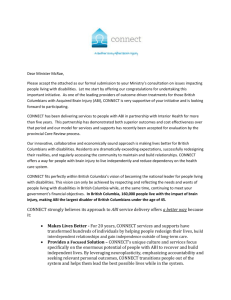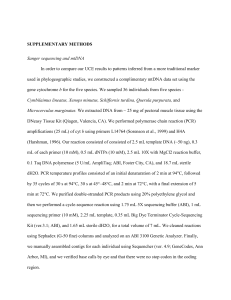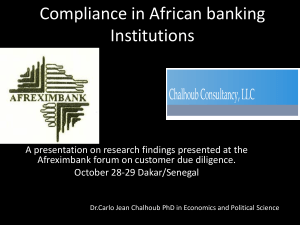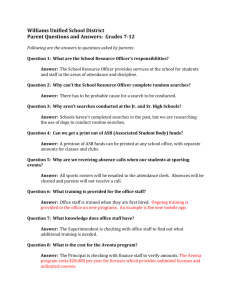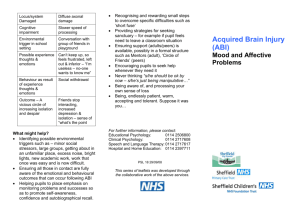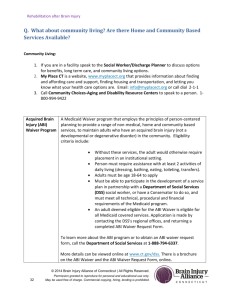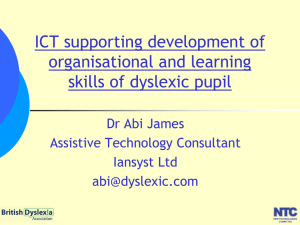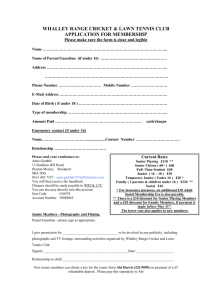Presentation
advertisement
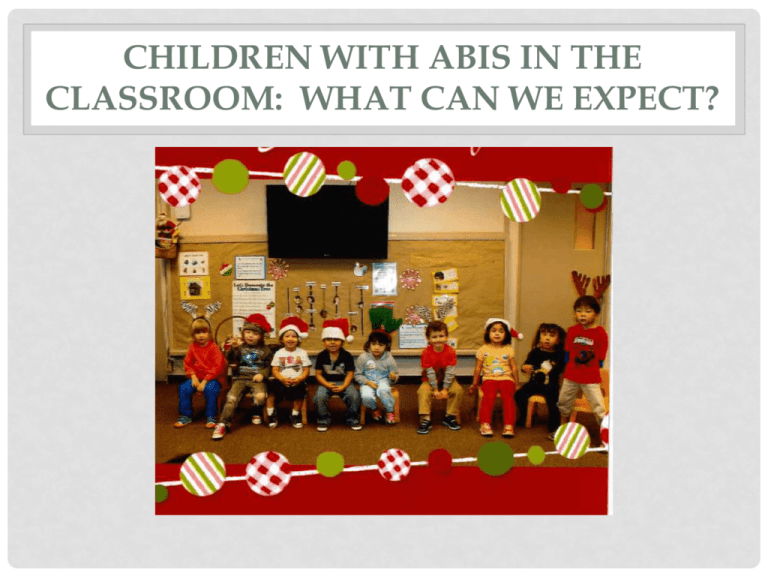
CHILDREN WITH ABIS IN THE CLASSROOM: WHAT CAN WE EXPECT? CI & ABI Candidacy Device Surgery Medical & Audiological Sites Research CANDIDACY • Not a CI candidate • • • • • • • • Neurofibromatosis Type 2 Absent VIII nerve Cochlear Nerve aplasia Auditory Neuropathy Cochlear Malformation Cochlear Ossification Head Trauma Inner Ear Scarring IMPLANTS Cochlear Implant http://www.medel.com/image-gallery/ Auditory Brain Implant http://www.medel.com/blog/neurofibromatosis-type-ii-hearing-loss/ DEVICE COMPARISON Photographs courtesy of Cochlear Ltd. ABI IMPLANTED Illustration courtesy of Cochlear Inc SOME OF THE IMPLANT & MAPPING LOCATIONS Worldwide • • • • • • • Belgium Germany Italy* Poland* Turkey* United Kingdom* USA (Clinical trials) • • • • Massachusetts Eye and Ear Infirmary University of North Carolina USC-CHLA – California … • Singapore*(mapping) • Spain • Sweden *Enrolled in programs at JTC ABIs in Children Colletti et al. (2014) Audiol Neurotol Vittorio Colletti MD First pediatric ABI In 2000 Data provided by USC, R. Shannon, et al Categories of Auditory Performance (CAP) 0. No awareness of environmental sounds or voice 1. Awareness of environmental sounds 2. Response to speech sounds 3. Identification of environmental sounds 4. Discrimination of speech sounds without lipreading 5. Understanding of common phrases without lipreading 6. Understanding of conversation without lipreading 7. Use of a telephone with known speaker 8. Follows group conversation in a reverberant room or where there is some interfering noise, such as a classroom or restaurant 9. Use of telephone with an unknown speaker in unpredictable context CAP Scores Children with NF2, AN, and Other 0. No awareness of environmental sounds or voice 1. Awareness of environmental sounds 2. Response to speech sounds CAP Scores Children with VIII Nerve Aplasia 3. Identification of environmental sounds 4. Discrimination of speech sounds without lipreading 5. Understanding of common phrases without lipreading CAP Scores Children with Ossification or Trauma 5. Understanding of common phrases without lipreading 6. Understanding of conversation without lipreading 7. Use of a telephone with known speaker COMPLEX NEAP • The Complex NEAP package is an assessment package for deaf children with complex needs which provide assessments, checklists and profiles to enable professionals and parents to assess and monitor the progress of deaf children with complex needs, in the areas of: • Communication and Language • Listening • Speech • Complex NEAP is based on the Nottingham Early Assessment Package (NEAP) and includes tools to facilitate the development of skilled observation in this special population. AUDITORY BRAINSTEM IMPLANT NIH CLINICAL TRAIL @ USC-CHLA Auditory Brainstem Implant NIH Clinical Trial @ USC-CHLA Initial activation of the ABI is analogous to a newborn entering the world and hearing for the first time, which means these children will need time to learn to interpret what they are sensing through the device as ‘sound,’” said USC Keck otolaryngology professor / study co-leader audiologist Laurie S. Eisenberg, Ph.D.. She adds that with the device, the child still needs to undergo therapy and interaction with, as their brains have to learn to map out the sounds and decode them: “The incoming stimulus for a child with an ABI is completely scrambled, and as a result, children with ABI require intensive long-term therapy and very strong parental involvement.” michelsonmedical.org ABI RESEARCH ABIS IN THE CLASSROOM Similarities • Developmental Milestones • Professionals to work with • Methodology • Reliance on Parent Participation Additional Considerations • Slower progress • Audiological support may not be local JTC’S CHILDREN WITH ABIS Demographics • • • • • 10 Children All under 6 years old 8 Countries 5 Boys & 5 Girls 8 in the Preschool • 5 Summer School • 3 Summer School & preschool the next year • 2 in Parent-Infant Etiology • Goldenhar or Goldenhar-Gorlin Syndrome • Auditory Nerve Deficiency • CHARGE • Cochlear Nerve Aplasia SURGERY DATA Implant Facility • Italy - 8 • Turkey -1 • England -1 • Single Sided • MedEl – 5 • Cochlear – 3 Implanted In • • • • • 2001 - 1 2002 - 1 2009 - 2 2012 - 4 2013 - 2 ABIS & EARLY OUTCOMES SHORT TERM STUDENTS Name Country/Center & Time at JTC ABI Age Devices & Fitting Ages Etiology/Other Challenges Impact Rating Listening Performance Language Performance Speech Performance UAE SS 2011 F 7/13/05 Nucleus ABI 39m Cochlear nerve aplasia Hypotonic, Oral-Motor, Torticollis 4 No Response 500-6K Home: English & Arabic Vocalizing /a/ Ireland (Manchester) SS 2012 C 11/19/08 Nucleus ABI 54m Premature Balance Gross motor delays; Absent auditory & vestibular nerves; Cochlear aplasia Poor audio thresholds Outside banana: 80dB Indicates env sounds Using sign language Good pragmatics Beginning vocalizations Some vowels Some plosives & nasals 9/28/10 Rt Medel ABI 22m Goldenhar Oral-Motor Good audio thresholds Detects all Ling 6 IDs /a/ vs /sh/ Responds to env. sound Good pragmatics Calls for attention Few vowels Few nasals 6/26/09 Medel ABI Goldenhar – Gorlin cleft lip & palate, lipoma of corpus callosum, dysgenesis of splenium of the corpus callosum, bilateral colobomas; Absent auditory & vestibular nerves; Oral-Motor/Feeding Fair audio thresholds IDs all Ling 6 at 1 ft Reports ABI off Responds to env sounds Uses ASL 5-word ASL phrases Single words: English Few vowels And /m/ 9/15/11 Rt Medel ABI 18m Lt HA CHARGE Mandarin/English Few single words: Bye-bye, no, come, sh Vocalizes with ABI Few vowels Few consonants UK SS 2014 O 7/31/11 Rt Medel ABI 20m Auditory nerve deficiency Goldenhar Scoliosis: walks with aid BSL & English Understands 10 signs Vocalizes Poland PI 2014 A March ‘12 UK (Italy & Manchester) SS 2013 E CA (Italy & C3) SS 2013 A CA (Italy & C3) PI 2013 B CHARGE, Malformed Leg, Vision Developmentally Delayed Detects all 6 IDs env sounds Puts ABI on if falls off Stops to “no” No detection of Ling 6 Stills to env sounds Responds to “no” Polish/English/Sign 4 © John Tracy Clinic 2015 ABIS & YEAR LONG PRESCHOOL STUDENTS Name Country/Center & Time at JTC UK (Italy &C3) 2010 DOB 8/6/06 Devices & Fitting Ages Etiology/Other Challenges Listening Performance Language Performance Speech Performance Nucleus ABI 31m Absent auditory nerves Vestibular/Balance Thresholds in banana IDs all Ling 6 Two critical elements Previously used BSL 4-5 word phrases Simple sentences “First me, and then you” PLS Total 3;1 @ 4;8 Many vowels Plosives, nasals, fricatives 2-3-word MLU “catch me, daddy” PLS 1 yr below CA Most vowels Most consonants Single words Vowels Few plosives/Stops Few nasals Singapore 2013 9/8/10 Rt Medel ABI 17m Auditory nerve deficiency Shortened frenulum Motor planning Oral-Motor/Feeding Turkey (Turkey) 2014 1/24/12 Rt ABI 21m Lt CI 32m Oral-Motor Good audio thresholds Reports ABI off 25dB across banana IDs all Ling 6 @ 3ft IDs 3 critical elements Poor audio thresholds Detects all Ling 6 with CI IDs /a/ with CI Nothing with ABI © John Tracy Clinic 2015 SOMETHING NEW… Teacher Concerns • What are their needs? • How are we going to accommodate their needs in an AVEd. Classroom? • What are acceptable articulation parameters? • How are we going to make a difference in three weeks? SHORT HISTORY OF CHANGE • • • • • • • • Unilateral-Single channel CI Variations of Multiple channel CI Digital Aids MRI OAE Auditory Neuropathy Bi-lateral CIs ABI LESSONS LEARNED FROM CI DEVELOPMENT • You can see trends coming - Learn all you can • Develop a Team Approach • Communication and Reporting Observations are key to progress • Outcomes Vary and Get Better Over Time • Confusion, Frustration and Doubt are part of learning… • So are… Optimism, Anticipation, and Discovery • It’s not magic – It’s work EXPECTATIONS FOR ABI DEVELOPMENT You can see trends coming - Learn all you can Develop a Team Approach Communication and Reporting Observations are key to progress Outcomes Vary Get Better Confusion, Frustration and Doubt are part of learning… So are… Optimism, Anticipation, and Discovery It’s not magic – It’s work ACTIVITY • • • • • Explorers Pioneers Settlers How do we know what each phase looks like? What are the skill sets with each level and what are the skills to nurture in each phase (parents)? MULTIDISCIPLINARY APPROACH HETEROGENEOUS LEARNERS: CLASSROOM AVEd. Classroom • Immediate audiological management • Acoustically controlled environments • Parent as Effective Facilitators • Provide focused and individualized instruction • Collaborate with parents and professionals • Promote spoken language self monitoring AVEd. Classroom + ABIs All of the AVEd. list and.. Small group lessons Higher adult-child ratio Adapt lesson for other learning needs • Use sandwiching technique to build into auditory learning • Integrate learning through movement • • • • VIDEO SPECIFIC CLASSROOM STRATEGIES • In children with hearing loss • Seating Arrangement • Sandwiching • Slow progress means??? For the ABI • Close Proximity • Environmental Acoustics • Sound Field Systems • Trouble Shooting LEARNING CHALLENGES LENA ABI Only ABI & CI PARENT SUPPORT GROUPS Different than in the ’80s – ’90s • Availability to stay supported through the internet • Many live at the implant site … • Facebook • Children with Auditory Brainstem • Auditory Brainstem Implant Technology Facebook COLLABORATIVE WORK REFERENCES
